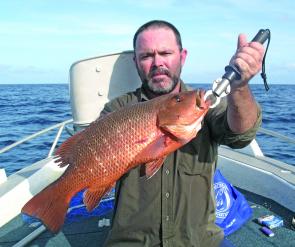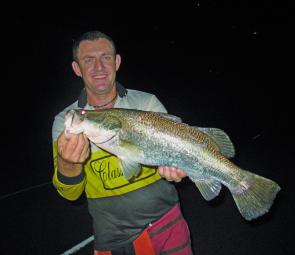Townsville has been experiencing the best wet season for decades, and subsequently the fishing has been sensational. Hopefully by early April, the freshwater will start to dissipate from the shoals and reefs to make way for the crystal clear kerosene waters that we are used too.
However, if the water doesn’t clear all is not lost! Over the last couple of months the green freshwater has also produced some spectacular fishing. Standard winter species, such as Spanish mackerel, have regularly been found gorging themselves on the abundant bait schools flushed out of the creeks. Even with a return to the salty blue water it won’t be long before the schools of Spaniards make their way up the coast for their winter migration.
The real buzz word for inshore fishing off Townsville has been grunter! Whether your fishing from the beach, bank or boat, large grunter up to 4.5kg have found baits of green back herring, squid, mullet strips or prawn almost irresistible.
The downside, if you could find one, is that beach fishers are finding a lot of queenfish mixed in with their catch of grunter. Fortunately the complaints to this downside would be few and far between as, although grunter are better eating, the fun and challenge of a jumping thrashing queenfish sure makes up for their lack of taste.
Barra, barra, barra! What can I say? For me, this has been the best start to a barra season for a lot of years and, fingers-crossed, every trip I have been on so far we have caught barra. Here’s hoping this trend continues as the season progresses.
At the moment live baiting is still the most successful method to use when targeting this sought-after species. Try using large baits of mullet or legal whiting. If the water cools, change over to a large banana prawn.
Fish your baits on a running rig with a sinker stopper about 40cm away from the hook. This technique allows your bait to swim free of the sinker and up off the bottom ensuring it presents well to the often fussing predator. If the tide is running make sure to hook your live fish bait through the lips as this holds him head first in the current so that he can swim naturally. When the current slows you can then hook him through the back behind the dorsal fin, but beware if you use this method when the current is running you will end up drowning your live bait.
The best places to try at present have been Morrisseys, Crocodile, Alligator and Coco creeks, as well as the Haughton, Bohle and Ross rivers. For many, the Ross River may seem like an odd addition to this list but, thanks to the efforts of the local fish stocking society, after the river floods there is a lot of large barra that have been flushed out of the weirs looking for a new home.
Trolling along the holes or gutters is a good way to find where these fish are hiding, or if you are a night owl try fishing on top of the sand on a big night tide on a bend. You will often find barra travelling across the tops of these sand bars in as little as 3ft of water, which makes it easier for them to see your bait.
The other popular option when targeting barra is to break out the tackle box and run some lures. Just remember that as the water cools, size down your lures. For instance, instead of trolling a 6” Barra Bait change to something about the size of a Sea Lure Barra Pro or even one of the many soft plastic prawn copies. The lead into winter can produce some hot sessions but you will find that the bite is often smaller, albeit more aggressive, when using and artificial bait.
April is the last recognised month for fingermark. Yes, I know that Queensland Fisheries have changed their name to golden snapper to match the territory, but I for one refuse to accept this until Fisheries management of Queensland finally catch up and copy some of the other more important things that have been implemented in the Northern Territory in relating to this species and many others.
Live squid are still the number one bait for fingermark, although green back and mud herring will also take quite a few fish. Again, as the water cools, don’t be scared to fish some live prawn around the same locations you fished over the summer months, such as Cape Cleveland, Bear or Bray islands, or Four Foot, Burdekin and Bay rocks. As with a lot of our summer fish they don’t disappear over winter they just change their feeding habits.
Reads: 1866
Lockie Cullen with a nice largemouth nannygai taken in shallow water while chasing trevally, but he really wasn’t complaining.

When Sonny Seimer from Broken Hill visited Townsville he managed to snag this good jack from a secret rock face.

Trolling along the holes or gutters is a good way to find where barra are hiding, or if you are a night owl try fishing on top of the sand on a big night tide on a bend.




